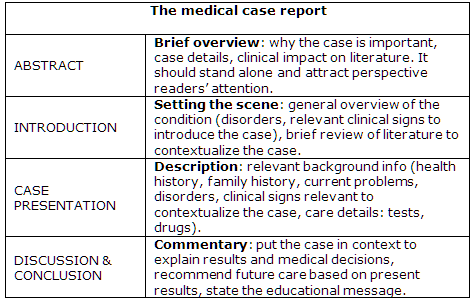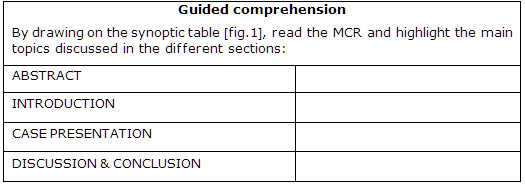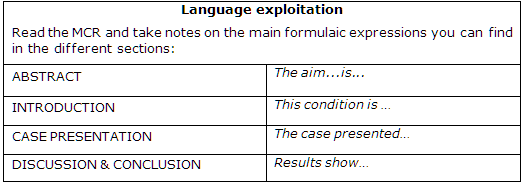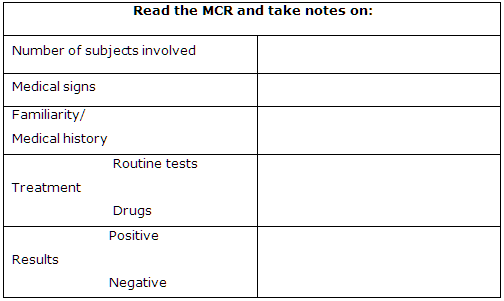

Home | Call for Papers | Submissions | Journal Info | Links |
Journal of the Slovene Association of LSP Teachers
ISSN: 1854-
Eugenio Cianflone
Academic genres in EFL medical educational contexts: the medical case-
ABSTRACT
In genre analysis literature medical case-
Keywords: medical case report, genre analysis, academic genres.
1. Introduction
It is a widely shared assumption that today English is the international language
of research and scholarship and the medium of election to spread scientific results
(Tardy, 2004). Recent data confirm this situation and show that 68% of worldwide
scholarly journals use English as their official language of publication; whereas
more than 95% of the scholarly papers indexed in the SCI (Science Citation Index)
are written in English, even by non-
This English-
For educational purposes, and considering the high share English has in academia,
the concept of text accessibility is of paramount importance to non-
The cornerstone of such scholarly research, which has helped a large cohort of non-
One written variety that, to the best of my knowledge, has not received consideration,
and is under-
The database used to illustrate the MCR layout and its main sections is taken from the guidelines written by Aitken and Marshall (2007) for their medical students. These outlines are, then, compared with the instruction to authors in two randomly selected medical journals. The first is the Journal of Medical Case Reports (JMCR), an open access journal wholly devoted to this type of papers in human medicine; the second is the Journal of Small Animal Practice (JSAP), an important scholarly paper in the veterinary medicine field.
2. The medical case-
In medicine and veterinary medicine, the MCR is a scientific genre used by medical
practitioners to describe unusual cases worth reporting because of their atypicalness.
In the specific, the MCR deals with a clinical condition and its care (Aitken and
Marshall, 2007: 133), new diseases or first reports of viruses’ mutations and related
therapies and prognoses (Vanderbroucke, 1999: 159-
Medical experts consider MCRs the “cornerstone of medical literature” (Vanderbroucke,
1999: 159) with a strong educational value in present day evidence-
Although MCRs can facilitate the progress of medical science and students’ education
and medical practitioners’ lifelong learning, MCRs are “perceived as an inferior
form of publication” (Mason, 2001: 100) by journals’ editors because the same are
infrequently quoted in research articles (Warner, 2005: 93-
3. The medical case-
MCRs are scholarly papers that accomplish their communicative and educational purposes
with a limited number of words, generally not exceeding 1500-
The MCR overall format resembles the research article (see Swales, 1990 and 2004) as it consists of the following sections: abstract, introduction, case description, discussion and conclusion (see tab. 1 for a synoptic description).
The abstract is a brief case overview (Aitken and Marshall, 2007: 134) whose aim
is to inform and to attract readers’ attention when scanning medical indexes. It
can include the following sub-
The introduction is the section which “sets the scene” (Aitken and Marshall, 2007: 134) and gives readers the general overview on the topic by describing the medical conditions or the main disorders peculiar to the case under discussion, together with hints on previous literature to contextualize the case (ibid.).
The case presentation section is a well developed part. It must contain clinical details of the patient’s health or his/her family history and a description of the clinical tests carried out and information on the care (ibid.).
The discussion & conclusion section is the most important component for medical readers
because it aims at putting the case into the right context (JMCR). It must comment
or critique the care (Aitken and Marshall, 2007: 135) by explaining treatment decisions
(JMCR), by outlining the importance of the case (JMCR) and its future use in everyday
medical practice or by stressing the educational message (Aitken and Marshall, 2007:
135-

Table 1: Synopsis of the MCR and its sections (Aitken and Marshall, 2007; JMCR)
4. The use of MCRs in EFL settings
To date, available literature on MCRs can be said to consist of “how to” tips written by medical educators for the medical audience interested in producing exemplars to be published in scholarly journals (e.g. Vanderbroucke, 1999; Wright and Kouroukis, 2000). No attention has been paid, to the best of my knowledge, on describing the MCR’s template for EFL study purposes and on designing activities to be used by language teachers in their EFL medical classes.
The following section wants, therefore, to try to fill in part this gap, by suggesting
some exercises to be employed in medical classes. The activities originate from
the MCR model discussed above and have been designed to boost text’s overall comprehension,
to call attention on some language expressions likely to be met in medical written
texts and to foster note-
The suggested exercises can be used with undergraduates or freshmen and serve the purpose of revising grammar items like the function of adjectives employed to describe care results, the use of tenses to describe the subjects’ medical or family history, biochemical tests or care results after drugs administration. The same exercises can also be applied in English for academic purposes classes and serve the purpose of introducing the communicative functions of the different MCR sections.
5. Language exploitation activities
The first proposed activity, namely a guided comprehension, can help learners focus on the message brought out by each section:

The second activity wants to highlight some formulaic expressions likely to be met in the MCRs different sections to implement medical English proficiency (some examples are given):

In the last activity presented in this note, MCRs can be used to develop note-

6. Conclusion
The aim of this note was to offer some insights on an under-
References
Aitken, L. M. and Marshall, A. P. (2007). Writing a case study: Ensuring a meaningful
contribution to the literature. Australian Critical Care, 20(4),132-
Bhatia, V. K. (1993). Analysing Genre: Language Use in professional Settings. London: Longman.
Dudley-
Hyland, K. (2006). English for academic Purposes, an advanced resource Book. London and New York: Routledge.
Hyland, K. (2009). Academic discourse. London: Continuum
Journal of Medical Case Reports (online). Available: http://medicalcasereports.com (15 March 2010).
Journal of Small Animal Practice (online). Available: http://www.wiley.com (15 March 2010).
Kidd, M. and Hubbard C. (2007). Introducing the Journal of medical Case Reports. Journal of medical Case Reports, 1(1), 1.
Mason, R. A. (2001). The case report-
Swales, J. M. (1990). Genre Analysis: English in Academic and Research Settings. Cambridge: Cambridge University Press.
Swales, J. M. (2004). Research Genres. Explorations and Applications. Cambridge: Cambridge University Press.
Tardy, C. (2004). The role of English in scientific communication: lingua franca
or Tyrannosaurus rex?. Journal of English for Academic Purposes, 3(3): 247-
Vandenbroucke, J. P. (1999). Case reports in an evidence-
Warner, J. O. (2005). Case reports-
Wright, S. M. and Kouroukis, C. (2000). Capturing zebras: What to do with a reportable
case. Canadian Medical Association Journal, 163(4), 429-
© 2005-
Scripta Manent Vol. 6(1-
» Contents
» E. Cianflone
Academic genres in EFL medical educational contexts: the medical case-
Apprendre les genres du secteur wallon de l’énergie. Un regard croisé sur les professionnels et le grand public
Combining Conversation Analysis and Reflective Practice in the LSP Classroom: Putting Transcripts of Business Simulations under the Microscope
Il vicino diverso. Percorsi di educazione interculturale di lingua italiana, da Nives Zudič Antonič e Metka Malčič.
Recensione
Terminologia professionale in italiano, da Maja Maričić.
Recensione
Previous Volumes